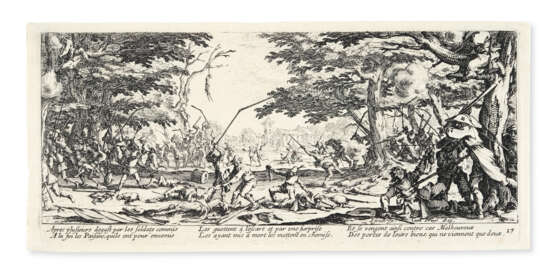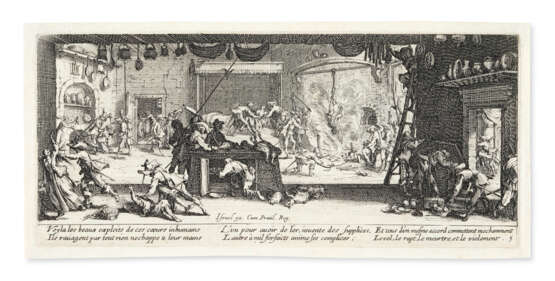ID 990987
Lot 3 | CALLOT, Jacques (1592-1635)
Estimate value
€ 1 500 – 2 000
Les Misères et les mal-heurs de la guerre. Paris : 1633.
Suite complète de l'une des plus célèbres réalisations de Jacques Callot. L'interprétation des planches la plus répandue consiste à y voir une dénonciation des ravages causés par la guerre de Trente Ans à la Lorraine natale de l'artiste. Le duché est envahi en 1631 par Louis XIII, et une capitulation totale est signée en 1633. Le roi demande alors à Callot de réaliser une gravure commémorant la prise de Nancy -l'artiste refuse, répondant qu'il préfèrerait se couper le pouce.
De manière plus universelle, la suite dénonce les atrocités de toutes les guerres, détaillant avec force détails les exactions commises par les soldats et les mercenaires. La dernière gravure voit un de ces hommes d'armes être récompensé pour leur "bonne conduite" à la guerre -conclusion ironique qui laisse supposer que le cycle recommencera. Lieure, n°1339-1356 ; Brunet,I, col. 1489 (« l’une des plus belles suites du maître ») ; Russell-Blanchard-Krill, 195-212.
Suite complète de 18 eaux-fortes, gravées par Israel Silvestre d'après les dessins de Jacques Callot, dont le titre, rognées dans le goût de l'époque : 93 x 196 mm. Le titre est en troisième état, et les autres planches en deuxième état. Les planches sont montées par trois sur de grands feuillets cartonnés.
Complete set of 18 etchings, after Callot. The title is in third state, and the other plates in second state.
| Artist: | Jacques Callot (1592 - 1635) |
|---|---|
| Place of origin: | France |
| Category: | Art prints |
| Artist: | Jacques Callot (1592 - 1635) |
|---|---|
| Place of origin: | France |
| Category: | Art prints |
| Address of auction |
CHRISTIE'S 9 Avenue Matignon 75008 Paris France | ||||||||||||||
|---|---|---|---|---|---|---|---|---|---|---|---|---|---|---|---|
| Preview |
| ||||||||||||||
| Phone | +33 (0)1 40 76 85 85 | ||||||||||||||
| Fax | +33 (0)1 40 76 85 86 | ||||||||||||||
| Conditions of purchase | Conditions of purchase | ||||||||||||||
| Shipping |
Postal service Courier service pickup by yourself | ||||||||||||||
| Payment methods |
Wire Transfer | ||||||||||||||
| Business hours | Business hours
|












